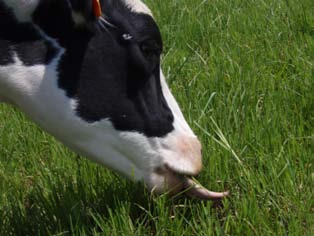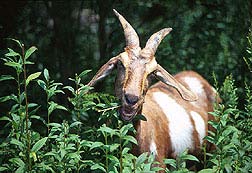Diet Selection and Grazing Behavior
Dr. Kathy Soder, USDA ARS Pasture Systems and Watershed Management
Research Unit
A grazing ruminant is presented with a smorgasbord of choices when turned out onto a pasture. However, little is understood on how selection decisions are made by the animal, including:
- How do these animals know what plants to eat and what to avoid?
- Can grazing ruminants ‘balance’ a diet by consuming various plants that complement each other nutritionally?
- Do their diet preferences change throughout the day, throughout the grazing season?
- Why do preferences change?
- How can we manage for these changes?

Grazing behavior research is attempting to address these issues to improve animal and pasture productivity. Studies conducted in the United Kingdom with perennial ryegrass and white clover pastures showed that, when given a choice, cattle and sheep preferred clover over ryegrass and consumed clover more rapidly than ryegrass. However, these animals do not consume a 100% clover diet. Why is that? If they prefer clover over ryegrass, wouldn’t we expect them to consume clover and ignore grass?
The UK work showed that, in reality, cattle and sheep preferred a diet (based on the choices presented to them) that is 50-70% clover, and 3050% ryegrass. Furthermore, clover was preferred in the morning while grass was preferred in the afternoon.
What is causing the switch from one forage to another? Why not continue eating the forage preferred first thing in the morning (in this case, clover)? Although we don’t yet have definitive answers, clues in the scientific literature and additional research may help solve this puzzle.
Grazing ruminants have 3-5 major ‘meals’ throughout the day (with mini grazing bouts in between the major meals), with the largest meal in the evening and the second largest meal in the early morning. Cattle, sheep and goats are prey animals that evolved to consume large quantities of high-fiber feeds in a relatively short time (often in open meadows where they were more prone to predation), then find a safe place to lie down and further chew (ruminate) their food. Ruminant animals typically lie down after dusk and remain relatively still during the night unless disturbed.

After chewing cud much of the night, their rumens have emptied substantially. In the UK work, the morning meal tended to consist of primarily clover (the preferred forage)…But why do they stop eating clover, and switch to grass (or vice versa)? Why does the evening meal contain primarily grass, when we know clover is the preferred forage?
Several theories exist concerning why preferences change. First, grazing animals may have learned through trial and error that clover causes bloat or other discomfort. Researchers at Utah State University conducted research on these post-ingestive feedback mechanisms and showed that when animals are made ill after consuming a food (particularly novel foods), they develop a strong aversion to that food.
Additionally, they will teach their offspring to avoid that food (even though under normal circumstances it may be a perfectly fine food for a ruminant). And those offspring remember those early lessons from ‘mom’ long into their lives. These researchers have also shown that ruminants are able to learn to ‘self-medicate’. Ruminants may consume a high clover diet, only to have bloat result. They relate the discomfort of bloat to the clover, and so, to avoid bloat, perhaps ruminants learned (through trial and error) to switch from clover to grass after they reach a particular satiation point, since grass is higher in fiber, has a slower passage rate, and may mediate the bloat affects.
The USU group has also shown how animals can ‘mix’ diets to mediate the effects of secondary compounds. For example, the ruminants consumed a certain level of a plant containing high tannin content, then switching to a plant containing high terpene level. By themselves, dietary consumption was low for each plant species, but when combined in the diet, dietary intake of each (and total dietary intake) increased.
Grazing ruminants may have inherently learned that grass ‘fills them up’ more for that long night-time fast, since grass typically contains more fiber than clover, causes more cud-chewing activity (which has been linked to deep-sleep patterns in ruminants), and has a slower passage rate out of the rumen.
The sugar content of grasses is higher in the afternoon than in the morning, which may influence preference for grasses throughout the day.

There is much to be learned about grazing behavior of ruminants. Pastures in the United States tend to be much more diverse than the ryegrass/clover pastures used in the UK studies. We do not yet know whether the same preferences occur with our diverse forages as what was seen in the previous studies with relatively few choices.
The USDA-ARS Pasture Systems and Watershed Management Research Unit is currently conducting research to answer these questions. Gaining a better understanding of diet preferences of grazing ruminants will help in developing improved grazing strategy recommendations, improved pasture mixture, and ultimately, improved animal and pasture productivity.